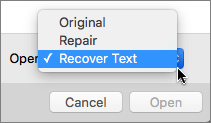Automatically save and recover files in Office for Mac
AutoSave, a feature that is available in Mac OS, saves your file automatically on a periodic basis. You can set how frequently files are saved. For example, if you set AutoSave to save every 5 minutes, you may recover more information in the event of data loss — such as from a power outage — than if it's set to save every 10 or 15 minutes. By default, AutoSave saves Office files every 10 minutes.
AutoRecover, a feature that is available in some Office applications, attempts to recover files automatically in the event of data loss. AutoRecover uses the same save interval as AutoSave.
Important: Do not use AutoSave and AutoRecover as a substitute for regularly saving your files by clicking Save  . Saving your files frequently is the best way to preserve your work.
. Saving your files frequently is the best way to preserve your work.
Which version of Office for Mac are you using?
Find an automatically saved or recovered file
The next time that you open an application, files in the AutoRecovery folder are listed in the Open Recent list. Or you can find the files in the Finder under /Users/<username>/Library/Containers/com.microsoft.Word/Data/Library/Preferences/AutoRecovery.
Note: If you close a file and click Don't Save, the file is deleted from the AutoRecovery folder.
Change how frequently files are automatically saved in Word, PowerPoint, or Excel
-
On the Word, PowerPoint, or Excel menu, click Preferences.
-
Click Save
 .
. -
In the Save AutoRecover info box, enter how frequently you want the program to save documents.
Change where to automatically save files in Word
-
On the Word menu, click Preferences.
-
Under Personal Settings, click File Locations
 .
. -
Under File locations, click AutoRecover files, and then click Modify.
-
Find the location where you want to automatically save files, and then click Open.
Recover text from a damaged file in Word
-
On the Word menu, click Preferences.
-
Under Authoring and Proofing Tools, click General
 .
. -
Make sure that the Confirm file format conversion at Open check box is selected, and then close the General dialog box.
-
Click File, Open.
-
On the Open menu towards the bottom right select Recover Text.

-
Open the document.
Find an automatically saved or recovered file
The next time that you open an application, files in the AutoRecovery folder are listed in the Open Recent list. Or you can find the files in the Finder under /Users/username/Library/Application Support/ Microsoft/Office/Office 2011 AutoRecovery.
Note: If you close a file and click Don't Save, the file is deleted from the AutoRecovery folder.
Word
Do any of the following:
Change how frequently files are automatically saved
-
On the Word menu, click Preferences.
-
Under Output and Sharing, click Save
 .
. -
In the AutoSave or AutoRecover info every box, enter how frequently you want Word to save documents.
Change where to automatically save files
-
On the Word menu, click Preferences.
-
Under Personal Settings, click File Locations
 .
. -
Under File locations, click AutoRecover files, and then click Modify.
-
Find the location where you want to automatically save files, and then click Choose.
Recover text from a damaged file
-
On the Word menu, click Preferences.
-
Under Authoring and Proofing Tools, click General
 .
. -
Make sure that the Confirm conversion at Open check box is selected, and then click OK.
-
On the Standard toolbar, click Open
 .
. -
On the Enable pop-up menu, click Recover Text from Any File.
-
Open the document.
PowerPoint
Do any of the following:
Change how frequently files are automatically saved
-
On the PowerPoint menu, click Preferences.
-
Click Save
 , select the AutoSave or AutoRecover info every check box, and then enter how frequently you want PowerPoint to save presentations.
, select the AutoSave or AutoRecover info every check box, and then enter how frequently you want PowerPoint to save presentations.
Excel
Do any of the following:
Change how frequently files are automatically saved
-
On the Excel menu, click Preferences.
-
Under Sharing and Privacy, click Save
 .
. -
Select the AutoSave or AutoRecover info every check box, and then enter how frequently you want Excel to save workbooks.
With this software you can easily repairs corrupt MS PowerPoint (.ppt/.pptx/.pptm) files to recover all inaccessible PowerPoint data. The software efficiently restores various PowerPoint objects, such as Tables, Header and Footer, Charts, WordArt objects, etc.
ReplyDeleteMicrosoft Office Tutorials: Automatically Save And Recover Files In Office For Mac >>>>> Download Now
ReplyDelete>>>>> Download Full
Microsoft Office Tutorials: Automatically Save And Recover Files In Office For Mac >>>>> Download LINK
>>>>> Download Now
Microsoft Office Tutorials: Automatically Save And Recover Files In Office For Mac >>>>> Download Full
>>>>> Download LINK 9L